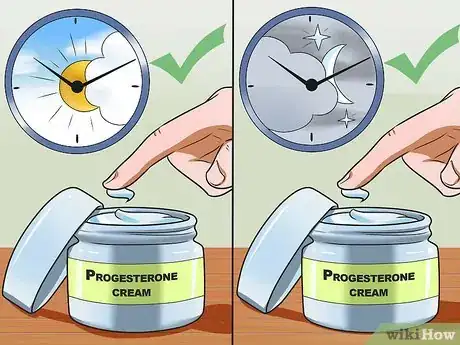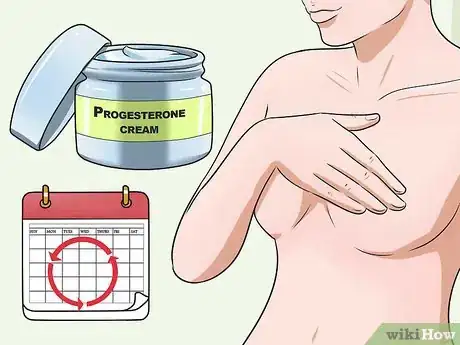This article was co-authored by David Nazarian, MD. Dr. David Nazarian is a board certified Internal Medicine Physician and the Owner of My Concierge MD, a medical practice in Beverly Hills California, specializing in concierge medicine, executive health and integrative medicine. Dr. Nazarian specializes in comprehensive physical examinations, IV Vitamin therapies, hormone replacement therapy, weight loss, platelet rich plasma therapies. He has over 16 years of medical training and facilitation and is a Diplomate of the American Board of Internal Medicine. He completed his B.S. in Psychology and Biology from the University of California, Los Angeles, his M.D. from the Sackler School of Medicine, and a residency at Huntington Memorial Hospital, an affiliate of the University of Southern California.
wikiHow marks an article as reader-approved once it receives enough positive feedback. In this case, several readers have written to tell us that this article was helpful to them, earning it our reader-approved status.
This article has been viewed 112,031 times.
Progesterone is a natural female hormone, and has been known to help women suffering from fertility issues. The hormone plays a very important role in fertility, as it maintains the lining of the uterus and makes it possible for a fertilized egg to attach and survive. You can boost your progesterone levels and increase fertility using a progesterone cream. It's important to understand the process and how it can affect your body.
Steps
Getting the Timing Right
-
1Calculate your menstrual cycle. Your hormones have a lot to do with your monthly period, so it is important to take your cycle into account when beginning to use the cream to raise your progesterone levels. Your hormones are working as a team to trigger ovulation, so it's important to help balance the hormones.
- You can chart your cycle by identifying the expected first day of your next period, then counting backwards two weeks (14 days) from then. This would be day 14 for a woman with a cycle duration of 28 days, or day 21 for another woman with a cycle duration of 35 days.
- The exact day will differ from woman to woman according to her calculations and her cycle's usual duration.
-
2Pick the right time of day. Generally, you will want to apply the cream twice a day, unless instructed otherwise by your doctor. Since you will likely want to apply the cream at home (so you don't have to tote it to work), you should choose two times when you are generally at home. Try to apply once in the morning, after your shower, and once at night, before bedtime.Advertisement
-
3Be consistent. As with any medication or supplement, it can be very helpful to get into a routine when applying your progesterone cream. Make it a habit to apply your cream at the same time each day. Soon, the application will be second nature, and you will be less likely to forget a dose.[1]
-
4Keep applying the cream if you become pregnant. If you learn that you are pregnant while using the cream, keep applying your normal doses. It is important that your progesterone levels do not drop early in a pregnancy, as that could result in loss of the fetus. Make sure to consult your doctor before you stop applying the cream.
Applying the Cream
-
1Choose the right spots. Progesterone cream is a fat-soluble substance, which makes it easily absorbed through the skin. It is best to choose spots on your body that have the greatest amounts of capillary blood, because it will be absorbed most quickly. There are many different spots that will work. You can rub small amounts of the cream into your neck, face, breasts, chest, and the insides of your hands.
-
2Rotate application spots. In order to avoid a particular area of your body becoming saturated, mix up the application spots each day. For example, do not apply to your neck both in the morning and the evening. If you have trouble remembering which spot you used last, just make a note and stick it to your bathroom mirror. That will serve as an easy reminder.
-
3Pay attention to dosage. When trying to become pregnant, you will typically need 30-40 milligrams of progesterone per day. The cream can easily be used to supplement what your body is supplying. Most creams come with instructions to apply about 20 milligrams twice a day. That is an amount about the size of 1/4 of a teaspoon.
-
4Ask your doctor questions. Make sure to discuss your specific fertility issues with your doctor to determine if progesterone cream will be right for you.Talk to your doctor if you have amenorrhea or a lack of a menstruation cycle. For women with amenorrhea (no period), it can be more difficult to use progesterone cream, as calculation of when to start the cream can be complicated.
Understanding Progesterone Cream
-
1Research different creams. Some progesterone creams are available over the counter, while others require a prescription from your doctor. You should ask your pharmacist about different options, and ask for details about the differences. When applying anything to your skin, make sure to read the ingredients and make sure that you do not have any known allergies.
-
2Shop around. If you decide to go with an over the counter option, you might want to try your local natural health store. Homeopathic remedies can be very successful, and you can ask the staff at a small store any questions you may have. You might receive more personalized advice than at a large chain store.
-
3Know the possible effects. While generally considered safe, progesterone can cause some unwanted side effects. Some users have reported issues such as upset stomachs and weight gain. Others have noticed depression-like or PMS-like symptoms. Remember, this cream contains hormones, so it will affect you physically.[2]
-
4Talk to your doctor. Before you start using progesterone cream, discuss your options with your doctor. Explain your concerns, and what you hope to gain from using the cream. Ask all of the questions that you have, and gain a clear understanding of what the cream can do for you.
Warnings
- Make sure to discuss any possible fertility treatments with a medical professional.⧼thumbs_response⧽
References
About This Article
Progesterone cream can help you become pregnant if you have fertility issues. You’ll want to apply the cream twice a day, once in the morning and once before you go to bed. Rub about 1/4 teaspoon of the cream into a spot where it will be easily absorbed, like your neck, face, breasts, chest, or the inside of your hands. Use a different spot each time you apply the cream so no area becomes saturated and can't absorb the cream effectively. If you become pregnant, keep applying the cream so your progesterone levels stay consistent. Consult your doctor about when to stop applying the cream. To learn about potential side effects of using progesterone cream, read on!
























-Step-12-Version-2.webp)


















































Medical Disclaimer
The content of this article is not intended to be a substitute for professional medical advice, examination, diagnosis, or treatment. You should always contact your doctor or other qualified healthcare professional before starting, changing, or stopping any kind of health treatment.
Read More...